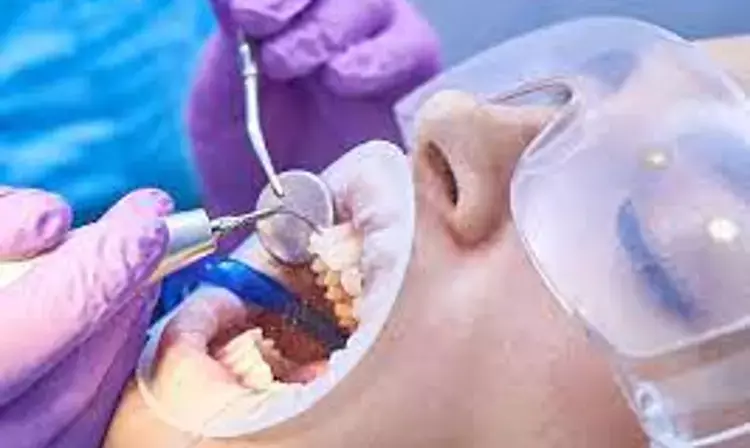- Home
- Medical news & Guidelines
- Anesthesiology
- Cardiology and CTVS
- Critical Care
- Dentistry
- Dermatology
- Diabetes and Endocrinology
- ENT
- Gastroenterology
- Medicine
- Nephrology
- Neurology
- Obstretics-Gynaecology
- Oncology
- Ophthalmology
- Orthopaedics
- Pediatrics-Neonatology
- Psychiatry
- Pulmonology
- Radiology
- Surgery
- Urology
- Laboratory Medicine
- Diet
- Nursing
- Paramedical
- Physiotherapy
- Health news
- Fact Check
- Bone Health Fact Check
- Brain Health Fact Check
- Cancer Related Fact Check
- Child Care Fact Check
- Dental and oral health fact check
- Diabetes and metabolic health fact check
- Diet and Nutrition Fact Check
- Eye and ENT Care Fact Check
- Fitness fact check
- Gut health fact check
- Heart health fact check
- Kidney health fact check
- Medical education fact check
- Men's health fact check
- Respiratory fact check
- Skin and hair care fact check
- Vaccine and Immunization fact check
- Women's health fact check
- AYUSH
- State News
- Andaman and Nicobar Islands
- Andhra Pradesh
- Arunachal Pradesh
- Assam
- Bihar
- Chandigarh
- Chattisgarh
- Dadra and Nagar Haveli
- Daman and Diu
- Delhi
- Goa
- Gujarat
- Haryana
- Himachal Pradesh
- Jammu & Kashmir
- Jharkhand
- Karnataka
- Kerala
- Ladakh
- Lakshadweep
- Madhya Pradesh
- Maharashtra
- Manipur
- Meghalaya
- Mizoram
- Nagaland
- Odisha
- Puducherry
- Punjab
- Rajasthan
- Sikkim
- Tamil Nadu
- Telangana
- Tripura
- Uttar Pradesh
- Uttrakhand
- West Bengal
- Medical Education
- Industry
Exposure to aerosols can be reduced with a drape, HVE, and extra oral suction in dentistry

The use of a surgical microscope and bag barrier drape, HVE, and extraoral suction device result in the lowest concentration of aerosolized particles, according to a recent study published in the Journal of the American Dental Association.
The COVID-19 pandemic has increased the importance of minimizing exposure to aerosols generated during dental procedures. The authors' objective was to measure the aerosolized particles in the breathing zone of operators using several facial protection and filtration methods.
Twenty-one dentists performed maxillary anterior incisor veneer preparations using a microscope and drape and loupes with or without a face shield. In each test condition, the following 3 levels of filtration were tested: no filtration, a high-volume evacuator [HVE], and an HVE with an extraoral suction device. Measurements were made using a mass monitor attached to the operator's chest with inlet within 10 inches of the operator's face.
The results of the study are:
The authors found that the microscope and drape provided the lowest levels of aerosolized particles compared with loupes with or without a face shield (P < .001). There was no detectable difference in the concentration of particles between operators wearing a face shield and wearing loupes alone (P = .47). The particles in each test condition were lowered when an HVE was used (P < .001) and further lowered with an extraoral suction device.
Thus, the findings of this study suggest that the use of a surgical microscope and bag barrier drape, HVE, and extraoral suction device result in the lowest concentration of aerosolized particles. The face shield did not appear to offer any protection from aerosolized particles. HVE and extraoral suction were effective in decreasing aerosols regardless of the type of facial protection used. Dentists can reduce exposure to aerosols with a drape, HVE, and extraoral suction.
Reference:
Effectiveness of barrier devices, high-volume evacuators, and extraoral suction devices on reducing dental aerosols for the dental operator: A pilot study by Wayne David Remington, et al. published in The Journal of the American Dental Association.
DOI: https://doi.org/10.1016/j.adaj.2021.08.011
Keywords:
The Journal of the American Dental Association, microscope, drape, aerosolized particles, microscope and bag barrier drape, HVE, and extraoral suction device, COVID-19, surgical microscope, Wayne David Remington, Brian Chandler Ott, Thomas Ryan Hartka,
Dr. Shravani Dali has completed her BDS from Pravara institute of medical sciences, loni. Following which she extensively worked in the healthcare sector for 2+ years. She has been actively involved in writing blogs in field of health and wellness. Currently she is pursuing her Masters of public health-health administration from Tata institute of social sciences. She can be contacted at editorial@medicaldialogues.in.
Dr Kamal Kant Kohli-MBBS, DTCD- a chest specialist with more than 30 years of practice and a flair for writing clinical articles, Dr Kamal Kant Kohli joined Medical Dialogues as a Chief Editor of Medical News. Besides writing articles, as an editor, he proofreads and verifies all the medical content published on Medical Dialogues including those coming from journals, studies,medical conferences,guidelines etc. Email: drkohli@medicaldialogues.in. Contact no. 011-43720751


